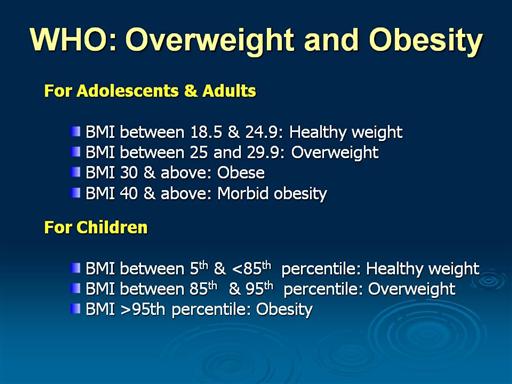| front |1 |2 |3 |4 |5 |6 |7 |8 |9 |10 |11 |12 |13 |14 |15 |16 |17 |18 |19 |20 |21 |22 |23 |24 |25 |26 |27 |28 |29 |30 |31 |32 |33 |34 |35 |36 |37 |38 |39 |40 |41 |42 |43 |44 |45 |46 |47 |48 |review |
 |
Obesity results from an imbalance in caloric intake relative to caloric expenditure. This imbalance causes fat to accumulate. Researchers usually define overweight and obesity in terms of an individualís body mass index, or BMI. BMI is calculated by dividing a personís weight in kilograms by his or her height in meters squared [kg/m2]. A person with a BMI over 25 is classified as overweight, while a person with a BMI of 30 or above is considered obese.
For example, a 6-foot (~1.8 m) tall man who weighs 180 pounds (~82 kg) has a BMI of about 24, which is at the upper end of the normal range. At 200 pounds (~91 kg), he has a BMI of about 27 and he is classified as overweight. At 225 pounds (~102 kg), he has a BMI of over 30, and he is obese.
Overweight is defined somewhat differently in children and adolescents. After BMI is calculated, it is plotted on growth charts -- based on national surveys compiled before the recent increase in obesity -- to obtain a percentile ranking. If a childís BMI is above the 85th percentile for his or her age, then he or she is at risk of becoming overweight. If a childís BMI is above the 95th percentile, the child is overweight. There is no generally accepted definition for obesity, as distinct from overweight, in this age group.
It is possible to have a high BMI and be healthy. For example, people who are athletic and have large amounts of muscle may have a BMI over 25, but are healthy. Also, BMI measurements cannot be used on pregnant women. Nevertheless, BMI is a useful tool. |